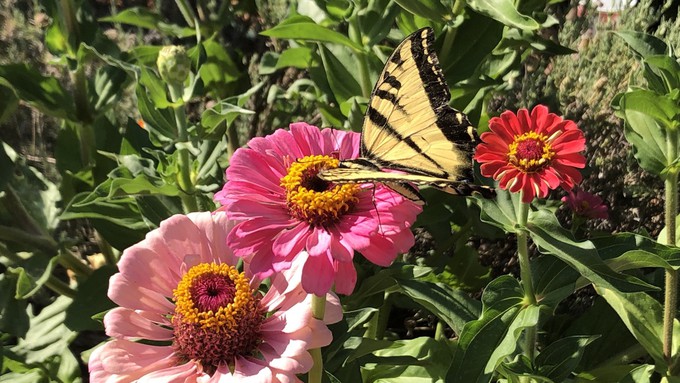
After record heat, some cool relief is on its way

Butterflies love zinnias. There is still plenty of time to plant flowers for late-summer splashes of color. Kathy Morrison
Get ready for a red-hot weekend before a return to more normal midsummer temperatures.
According to the National Weather Service, Sacramento and other inland cities have already broken heat records with more possible.
“There was some record heat today!” tweeted the NWS Sacramento office Friday night. “A daily record of 108 was set in downtown Sacramento, breaking the previous record of 106 set in 1996. Records of 112 were tied for Redding Airport (1988) and for Red Bluff Airport (1961).”
It could be even hotter some places this weekend before our Delta breeze returns Sunday night.
“Very hot weather will continue across interior #NorCal today with record highs possible,” added the weather service Saturday. “Temperatures will begin to trend downward beginning Sunday, and will be around average early next week.”
For the record book, Sacramento’s all-time record high – 116 degrees – was set Sept. 6 last year. That broke a record of 114 that had stood since 1925.
“If you have access to air conditioning, use it,” cautioned the weather service on Saturday. “Fans may not be adequate.”
Fortunately, this heat wave is expected to pass soon. According to the weather service, Sacramento will be back in the 90s by Monday with a forecast high of 97 – normal for late July. By Wednesday, breezy conditions will keep afternoons refreshingly cool; the forecast high for Thursday and Friday is 91 degrees – 17 degrees cooler than that record July 21.
With that in mind, postpone outdoor tasks such as mowing, weeding and planting until midweek or later if possible. Even on those cooler days, take advantage of early mornings when temperatures will be only in the 60s or 70s.
* One good thing about hot days: Most lawns stop growing when temperatures top 95 degrees. When you do mow, set mower blades on high; taller grass shades its roots and copes better with high heat.
* Keep your vegetable garden watered, mulched and weeded. Water before 8 a.m. to reduce the chance of fungal infection and to conserve moisture.
* Wait on fertilizing vegetables and blooming annuals until temperatures cool later this week. Make sure to water deeply before feeding.
* Don’t let tomatoes wilt or dry out completely. Give tomatoes a deep watering two to three times a week.
* Harvest vegetables promptly to encourage plants to produce more. Squash especially tends to grow rapidly in hot weather. Keep an eye on zucchini.
* Pinch back chrysanthemums for bushy plants and more flowers in September.
* Remove spent flowers from roses, daylilies and other bloomers as they finish flowering.
* Pinch off blooms from basil so the plant will grow more leaves.
* Cut back lavender after flowering to promote a second bloom.
* It’s not too late to add a splash of color. Plant petunias, snapdragons, zinnias and marigolds; all are great for containers.
* From seed, plant corn, pumpkins, radishes, winter squash and sunflowers.
* Indoors, start seedlings for fall vegetable planting, including bunching onion, cabbage, broccoli, cauliflower, kale, radicchio and lettuce.
* Sow seeds of perennials in pots for fall planting including yarrow, coneflower and salvia.
Comments
0 comments have been posted.Sacramento Digs Gardening to your inbox.
Food in My Back Yard Series
April 29: What's (already) wrong with my tomato plants?
April 22: Should you stock up on fertilizer? (Yes!)
April 15: Grow culinary herbs in containers
April 8: When to plant summer vegetables
April 1: Don't be fooled by these garden myths
March 25: Fertilizer tips: How to 'feed' your vegetables for healthy growth
March 18: Time to give vegetable seedlings some more space
March 11: Ways to win the fight against weeds
March 4: Potatoes from the garden
Feb. 25: Plant a fruit tree now -- for later
Feb. 18: How to squeeze more food into less space
Feb. 11: When to plant? Consider staggering your transplants
Feb. 4: Starting in seed starting
Sites We Like
Garden Checklist for week of May 4
Enjoy this spring weather – and get gardening!
* Plant, plant, plant! It’s prime planting season in the Sacramento area. Time to set out those tomato transplants along with peppers and eggplants. Pinch off any flowers on new transplants to make them concentrate on establishing roots instead of setting premature fruit.
* Direct-seed melons, cucumbers, summer squash, corn, radishes, pumpkins and annual herbs such as basil.
* Harvest cabbage, lettuce, peas and green onions.
* In the flower garden, direct-seed sunflowers, cosmos, salvia, zinnias, marigolds, celosia and asters. (You also can transplant seedlings for many of the same flowers.)
* Plant dahlia tubers. Other perennials to set out include verbena, coreopsis, coneflower and astilbe.
* Transplant petunias, marigolds and perennial flowers such as astilbe, columbine, coneflowers, coreopsis, dahlias, rudbeckia and verbena.
* Keep an eye out for slugs, snails, earwigs and aphids that want to dine on tender new growth.
* Feed summer bloomers with a balanced fertilizer.
* For continued bloom, cut off spent flowers on roses as well as other flowering plants.
* Add mulch to the garden to maintain moisture. Mulch also cuts down on weeds. But don’t let it mound around the stems or trunks of trees or shrubs. Leave about a 6-inch to 1-foot circle to avoid crown rot or other problems.